
The Tegetthoff class was a class of four dreadnought battleships built for the Austro-Hungarian Navy. Named for Austrian Admiral Wilhelm von Tegetthoff, the class was composed of SMS Viribus Unitis, SMS Tegetthoff, SMS Prinz Eugen, and SMS Szent István. Construction started on the ships shortly before World War I; Viribus Unitis and Tegetthoff were both laid down in 1910, Prinz Eugen and Szent István followed in 1912. Three of the four warships were built in the Stabilimento Tecnico Triestino shipyard in Trieste; Szent István was built in the Ganz-Danubius shipyard in Fiume, so that both parts of the Dual Monarchy would participate in the construction of the ships. The Tegetthoff-class ships hold the distinction for being the first and only dreadnought battleships of the Austro-Hungarian Navy. The SMS Szent István had a different more modern propulsion system than her sister ships.
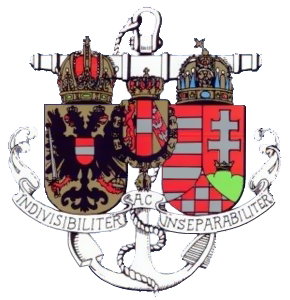
The Austro-Hungarian Navy or Imperial and Royal War Navy was the naval force of Austria-Hungary. Ships of the Austro-Hungarian Navy were designated SMS, for Seiner Majestät Schiff. The k.u.k. Kriegsmarine came into being after the formation of Austria-Hungary in 1867, and ceased to exist in 1918 upon the Empire's defeat and subsequent collapse at the end of World War I.

SMS Viribus Unitis was an Austro-Hungarian dreadnought battleship, the first of the Tegetthoff class. "Viribus Unitis", meaning "With United Forces", was the personal motto of Emperor Franz Joseph I.

SMS Prinz Eugen was the third of four Tegetthoff-class dreadnought battleships built for the Austro-Hungarian Navy. Prinz Eugen was named for Prince Eugene of Savoy, a Habsburg general and statesman during the 17th and 18th centuries most notable for defeating the Ottoman Empire at the Battle of Zenta in 1697. The ship was armed with a main battery of twelve 30.5 cm (12.0 in) guns in four triple turrets. Constructed shortly before World War I, she was built at the Stabilimento Tecnico Triestino shipyard in Trieste, where she was laid down in January 1912 and launched in November that same year.
Prince Eugene most commonly refers to:
Stabilimento Tecnico Triestino (STT) ("Technical Establishment of Trieste") was a private shipbuilding company based in Trieste from the mid-19th to early 20th century, and the most important naval shipbuilding firm of the Austro-Hungarian Empire.

The Adriatic Campaign of World War I was a naval campaign fought between the Central Powers and the Mediterranean squadrons of Great Britain, France, the Kingdom of Italy, Australia, and the United States.

SMS Leopard was a torpedo cruiser (Torpedoschiff) of the Austro-Hungarian Navy. She and her sister ship, SMS Panther, were part of a program to build up Austria-Hungary's fleet of torpedo craft in the 1880s. Both ships, the only members of the Panther class, were built in Britain at the Armstrong shipyard in Elswick. Leopard was laid down in January 1885, launched in September 1885, and completed in March 1886. She was armed with a battery of two 12 cm (4.7 in) guns and ten 47 mm (1.9 in) guns, along with four 356 mm (14 in) torpedo tubes.

The Bombardment of Ancona was a naval engagement of the Adriatic Campaign of World War I between the navies of Italy and Austria-Hungary. Forces of the Imperial and Royal Navy attacked and bombarded military and civilian targets all across Ancona in central Italy and several other nearby islands and communities in response to Italy's declaration of war on Austria-Hungary.
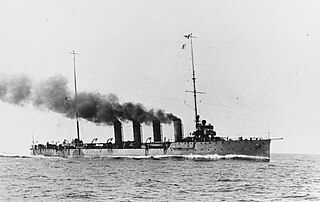
SMS Saida was a Novara-class scout cruiser built for the Austro-Hungarian Navy in the early 1910s. The ship was armed with a main battery of nine 10 cm (3.9 in) guns, and six twin 53.3 cm (21.0 in) torpedo tubes were added in 1917. She was built by the Cantiere Navale Triestino shipyard from 1911 to 1914, entering service days after the outbreak of World War I. She spent the war as a flotilla leader, conducting raids and patrols in the narrow waters of the Adriatic Sea.
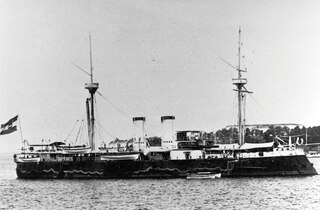
SMS Kronprinzessin Erzherzogin Stephanie was an ironclad warship built for the Austro-Hungarian Navy in the 1880s, the last vessel of that type to be built for Austria-Hungary. The ship, named for Archduchess Stephanie, Crown Princess of Austria, was laid down in November 1884, was launched in April 1887 and completed in July 1889. She was armed with a pair of 30.5-centimeter (12 in) guns in open barbettes and had a top speed of 17 knots. Her service was limited, in large part due to the rapid pace of naval development in the 1890s, which quickly rendered her obsolescent. As a result, her career was generally limited to routine training and the occasional visit to foreign countries. In 1897, she took part in an international naval demonstration to force a compromise over Greek and Ottoman claims to the island of Crete. Kronprinzessin Erzherzogin Stephanie was decommissioned in 1905, hulked in 1910, and converted into a barracks ship in 1914. After Austria-Hungary's defeat in World War I, the ship was transferred to Italy as a war prize and was eventually broken up for scrap in 1926.

SMS Kaiser Max was an ironclad warship built for the Austro-Hungarian Navy in the 1870s, the lead ship of the Kaiser Max class. The ship was purportedly the same vessel that had been laid down in 1861, and had simply been reconstructed. This was a fiction, however; the head of the Austro-Hungarian Navy could not secure funding for new ships, but reconstruction projects were uncontroversial, so he "rebuilt" the three earlier Kaiser Max-class ironclads. Only the engines and parts of the armor plate were reused in the new Kaiser Max, which was laid down in February 1874, launched in December 1875, and commissioned in October 1876. The ship's career was fairly limited, in part due to slender naval budgets that prevented much active use. She made foreign visits and took part in limited training exercises in the 1880s and 1890s. Long since obsolete, Kaiser Max was removed from service in 1904 and converted into a barracks ship. After World War I, the ship was transferred to the Royal Yugoslav Navy as a war prize and renamed Tivat. Her fate thereafter is uncertain, either being sold for scrap in 1924 or retained through 1941.

SMS Prinz Eugen was an ironclad warship built for the Austro-Hungarian Navy in the 1870s, the third and final member of the Kaiser Max class. The ship was supposedly the same vessel that had been laid down in 1861, and had simply been reconstructed. In reality, the head of the Austro-Hungarian Navy could not secure funding for new ships, but reconstruction projects were uncontroversial, so he "rebuilt" the three earlier Kaiser Max-class ironclads. Only the engines and parts of the armor plate were reused in the new Prinz Eugen, which was laid down in October 1874, launched in September 1877, and commissioned in November 1878. The ship spent significant periods out of service, in part due to slender naval budgets that prevented much active use. In 1880, she took part in an international naval demonstration against the Ottoman Empire, and she went to Spain in 1888 for the Barcelona Universal Exposition. Prinz Eugen was stricken in 1904 and converted into a repair ship in 1906–1909. She was renamed Vulkan and served in this capacity through World War I; after the war, she was seized by Italy but was awarded to Yugoslavia in the postwar peace negotiations. Italy refused to hand the ship over, however, and her ultimate fate is unknown.

SMS Don Juan d'Austria was an ironclad warship built for the Austro-Hungarian Navy in the 1870s, the second of the three ships of the Kaiser Max class. The ship was purportedly the same vessel that had been laid down in 1861, and had simply been reconstructed. This was a fiction, however; the head of the Austro-Hungarian Navy could not secure funding for new ships, but reconstruction projects were uncontroversial, so he "rebuilt" the three earlier Kaiser Max-class ironclads. Only the engines and parts of the armor plate were reused in the new Don Juan d'Austria, which was laid down in February 1874, launched in December 1875, and commissioned in October 1876. The ship's career was fairly limited, in part due to slender naval budgets that prevented much active use. She made foreign visits and took part in limited training exercises in the 1880s and 1890s. Long since obsolete, Don Juan d'Austria was removed from service in 1904 and used as a barracks ship through World War I. After the war, she sank under unclear circumstances.

SMS Custoza was an ironclad warship built for the Austro-Hungarian Navy in the 1870s, the only member of her class. She was the first Austro-Hungarian ironclad to be built after the navy studied the results of the Battle of Lissa of 1866; she was also the first iron-hulled capital ship to be built for the Austro-Hungarian Navy. She was laid down in November 1869, launched in August 1872, and completed in February 1875. Her career was fairly limited, in part due to reduced naval budgets in the 1870s that also delayed her completion. Custoza was somewhat more active in the 1880s, taking part in an international naval demonstration against the Ottoman Empire in 1880, being modernized in 1882, and a trip to Spain for the Barcelona Universal Exposition in 1888. The ship became a training ship in 1902, was converted into a barracks ship in 1914, and after World War I, was awarded as a war prize to Italy. Custoza was immediately broken up.
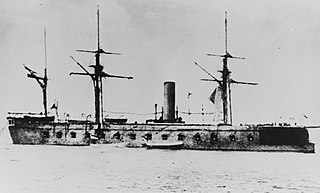
SMS Prinz Eugen was the second member of the Kaiser Max class built for the Austrian Navy in the 1860s. Her keel was laid in October 1861 at the Stabilimento Tecnico Triestino shipyard; she was launched in June 1862, and was completed in March 1863. She carried her main battery—composed of sixteen 48-pounder guns and fifteen 24-pounders—in a traditional broadside arrangement, protected by an armored belt that was 110 mm (4.3 in) thick.
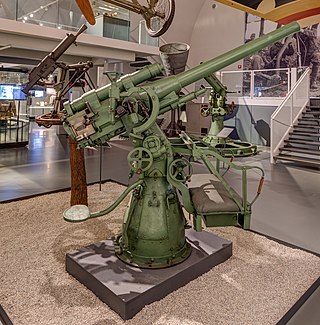
The Škoda 7 cm K10 was a dual-purpose gun of the Austro-Hungarian Empire that was used by the Austro-Hungarian Navy during World War I. The gun was actually 66 mm, but the classification system for artillery rounded up to the next highest centimeter. The 7 cm K10 was also used by the Italian Navy on ships ceded as war reparations and as coastal artillery during World War II. The Italians referred to it as the 66/47.

The Novara class was a class of three scout cruisers built for the Austro-Hungarian Navy. Named for the Battle of Novara, the class comprised SMS Saida, SMS Helgoland, and SMS Novara. Construction started on the ships shortly before World War I; Saida and Helgoland were both laid down in 1911, Novara followed in 1912. Two of the three warships were built in the Ganz-Danubius shipyard in Fiume; Saida was built in the Cantiere Navale Triestino shipyard in Monfalcone. The Novara-class ships hold the distinction for being the last cruisers constructed by the Austro-Hungarian Navy.
Eugen is a masculine given name. It may also refer to:














